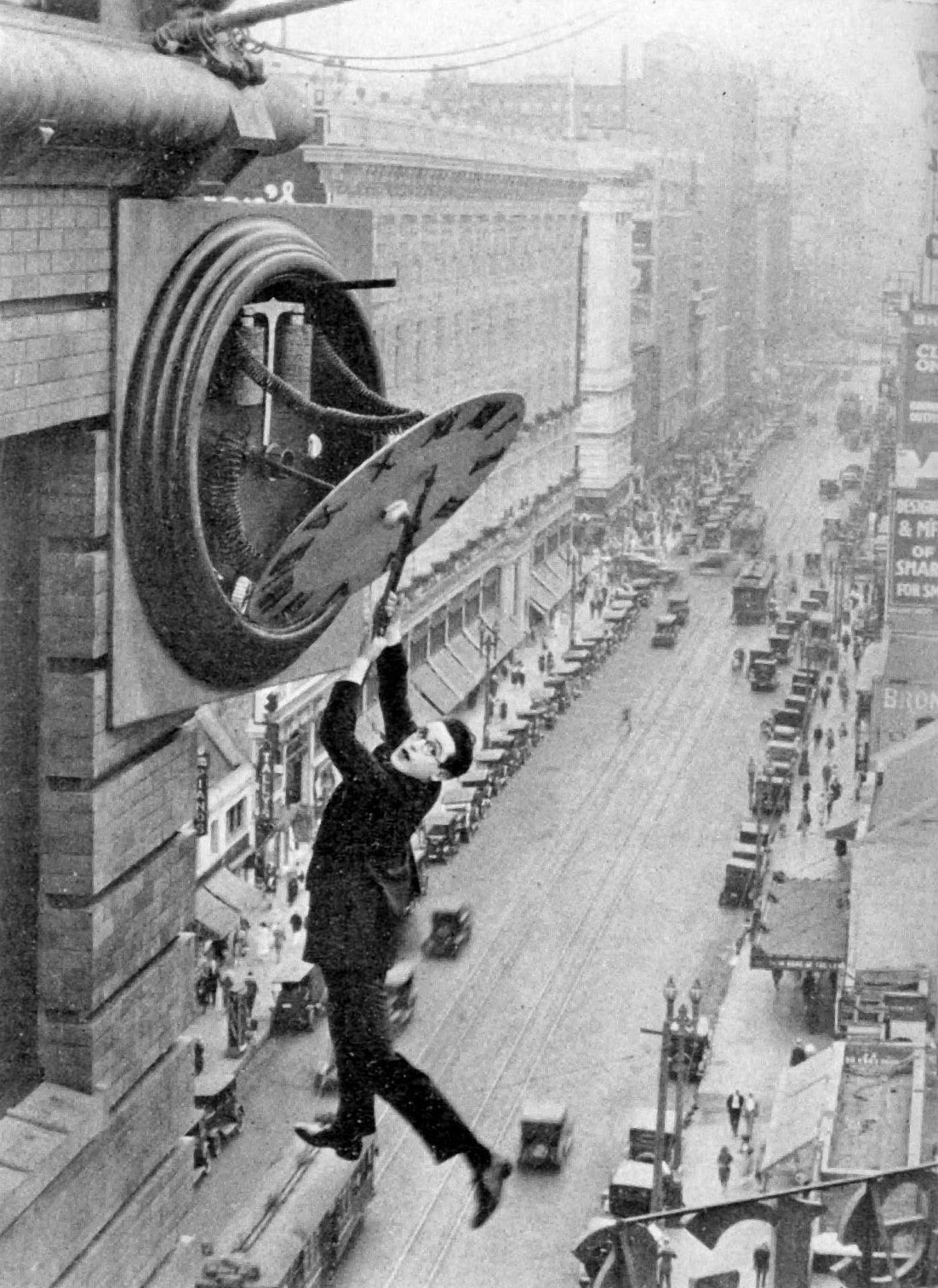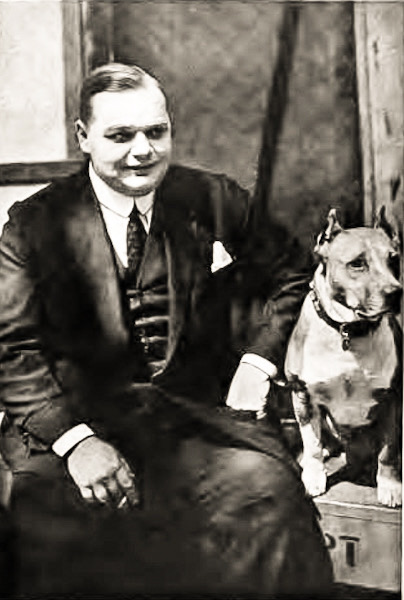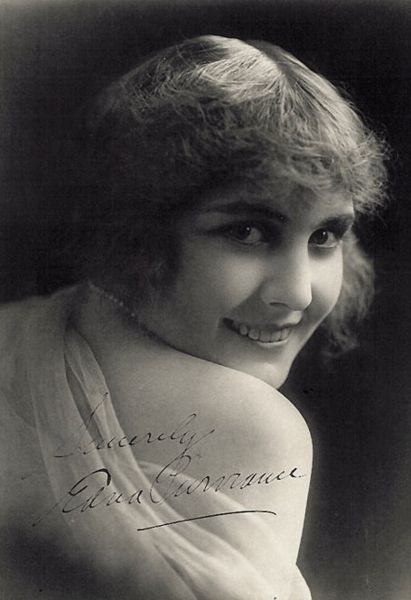|
Silent Comedy
Silent comedy is a style of film, related to but distinct from mime, invented to bring comedy into the medium of film in the silent film era (1900s–1920s) before a synchronized soundtrack which could include talking was technologically available for the majority of films. Silent comedy is still practiced, albeit much less frequently, and it has influenced comedy in modern media as well. Many of the techniques of silent comedy were borrowed from vaudeville traditions with many silent comedies such as Buster Keaton and Charlie Chaplin getting their start in vaudeville. Silent comedies often place heavy emphasis on visual and physical humors, often including "sight gags", to tell stories and entertain the viewer. Many of these physical gags are exaggerated forms of violence which came to be called " slapstick". The "prat fall", slipping on a banana peel, getting soaked with water, and getting a pie thrown in one's face are all classic examples of slapstick comedy devices. ... [...More Info...] [...Related Items...] OR: [Wikipedia] [Google] [Baidu] |
Intertitle
In films, an intertitle, also known as a title card, is a piece of filmed, printed text edited into the midst of (i.e., ''inter-'') the photographed action at various points. Intertitles used to convey character dialogue are referred to as "dialogue intertitles", and those used to provide related descriptive/narrative material are referred to as "expository intertitles". In modern usage, the terms refer to similar text and logo material inserted at or near the start or end of films and television shows. Silent film era In this era intertitles were mostly called "subtitles" and often had Art Deco motifs. They were a mainstay of silent films once the films became of sufficient length and detail to necessitate dialogue or narration to make sense of the enacted or documented events. ''The British Film Catalogue'' credits the 1898 film ''Our New General Servant'' by Robert W. Paul as the first British film to use intertitles. Film scholar Kamilla Elliott identifies another early use o ... [...More Info...] [...Related Items...] OR: [Wikipedia] [Google] [Baidu] |
Larry Semon
Lawrence Semon (February 9, 1889 – October 8, 1928) was an American actor, director, producer, and screenwriter during the silent film era. In his day, Semon was considered a major movie comedian, but he is now remembered mainly for working with both Stan Laurel and Oliver Hardy before they started working together. He is also sometimes noted for directing (as well as appearing in) the 1925 silent film '' The Wizard of Oz'', which had a slight influence on the better-known 1939 talkie '' The Wizard of Oz'' released by MGM. The film was included in the 2005 three-disc DVD version of the 1939 film, along with other silent ''Oz'' movies. Early life Born in West Point, Mississippi, Semon was the son of a travelling Jewish vaudeville magician Zera Semon, who billed himself as "Zera the Great". His mother, Irene Semon (née Rea) worked as his assistant. Along with his older sister, Semon joined his parents' act until his father's death. After completing his education in Savanna ... [...More Info...] [...Related Items...] OR: [Wikipedia] [Google] [Baidu] |
Harold Lloyd
Harold Clayton Lloyd, Sr. (April 20, 1893 – March 8, 1971) was an American actor, comedian, and stunt performer who appeared in many silent comedy films.Obituary '' Variety'', March 10, 1971, page 55. One of the most influential film comedians of the silent film era, Lloyd made nearly 200 comedy films, both silent and " talkies", between 1914 and 1947. His bespectacled "Glass" character was a resourceful, ambitious go-getter who matched the zeitgeist of the 1920s-era United States. His films frequently contained "thrill sequences" of extended chase scenes and daredevil physical feats. Lloyd hanging from the hands of a clock high above the street (dangerous, but risk exaggerated by camera angles) in ''Safety Last!'' (1923) is considered one of the most enduring images in cinema. Lloyd performed lesser stunts himself, despite having injured himself in August 1919 while doing publicity pictures for the Roach studio. An accident with a bomb mistaken as a prop resulted in t ... [...More Info...] [...Related Items...] OR: [Wikipedia] [Google] [Baidu] |
Fatty Arbuckle
Roscoe Conkling "Fatty" Arbuckle (; March 24, 1887 – June 29, 1933) was an American silent film actor, comedian, director, and screenwriter. He started at the Selig Polyscope Company and eventually moved to Keystone Studios, where he worked with Mabel Normand and Harold Lloyd as well as with his nephew, Al St. John. He also mentored Charlie Chaplin, Monty Banks and Bob Hope, and brought vaudeville star Buster Keaton into the movie business. Arbuckle was one of the most popular silent stars of the 1910s and one of the highest-paid actors in Hollywood, signing a contract in 1920 with Paramount Pictures for $14,000 (). Arbuckle was the defendant in three widely publicized trials between November 1921 and April 1922 for the rape and manslaughter of actress Virginia Rappe. Rappe had fallen ill at a party hosted by Arbuckle at San Francisco's St. Francis Hotel in September 1921, and died four days later. A friend of Rappe accused Arbuckle of raping and accidentally killing her. Th ... [...More Info...] [...Related Items...] OR: [Wikipedia] [Google] [Baidu] |
Edna Purviance
Olga Edna Purviance (; October 21, 1895 – January 13, 1958) was an American actress of the silent film era. She was the leading lady in many of Charlie Chaplin's early films and in a span of eight years, she appeared in over 30 films with him. Life and career 1895–1913: Early life Edna Purviance was born in October 21,1895, in Paradise Valley, Nevada, United States of America, to English immigrant Louisa Wright Davey and American vintner to the western mining camps Madison (Matt) Gates Purviance. When she was three, the family moved to Lovelock, Nevada, where they assumed ownership of a hotel. Her parents divorced in 1902, and her mother later married Robert Nurnberger, a German plumber. Growing up, Purviance was a talented pianist. She left Lovelock in 1913 and moved in with her married sister Bessie while attending business college in San Francisco. 1914–1927: Film career In 1915, Purviance was working as a secretary in San Francisco when actor and director Charlie C ... [...More Info...] [...Related Items...] OR: [Wikipedia] [Google] [Baidu] |
Mabel Normand
Amabel Ethelreid Normand (November 9, 1893 – February 23, 1930), better known as Mabel Normand, was an American silent film actress, screenwriter, director, and producer. She was a popular star and collaborator of Mack Sennett in their Keystone Studios films, and at the height of her career in the late 1910s and early 1920s had her own film studio and production company. Onscreen, she appeared in twelve successful films with Charlie Chaplin and seventeen with Roscoe "Fatty" Arbuckle, sometimes writing and directing (or co-writing/directing) films featuring Chaplin as her leading man. In the 1920s, Normand's name was linked with scandal, including the 1922 murder of William Desmond Taylor and the 1924 shooting of Courtland S. Dines. Dines was shot by Normand's chauffeur, who was using her pistol. She was exonerated in the first crime, and disregarded from the second, but her film career declined. In addition, Normand suffered a recurrence of tuberculosis in 1923, which ... [...More Info...] [...Related Items...] OR: [Wikipedia] [Google] [Baidu] |
Keystone Cops
The Keystone Cops (often spelled "Keystone Kops") are fictional, humorously incompetent policemen featured in silent film slapstick comedies produced by Mack Sennett for his Keystone Film Company between 1912 and 1917. History The idea for the Keystone Cops came from Hank Mann, and they were named for the Keystone studio, the film production company founded in 1912 by Sennett. Their first film was ''Hoffmeyer's Legacy'' (1912), with Mann playing the part of police chief Tehiezel, but their popularity stemmed from the 1913 short ''The Bangville Police'' starring Mabel Normand, which had Ford Sterling in the role of chief. As early as 1914, Sennett shifted the Keystone Cops from starring roles to background ensemble in support of comedians such as Charlie Chaplin and Fatty Arbuckle. The Keystone Cops served as supporting players for Marie Dressler, Mabel Normand, and Chaplin in the first full-length Sennett comedy feature '' Tillie's Punctured Romance'' (1914); ''Mabel's New ... [...More Info...] [...Related Items...] OR: [Wikipedia] [Google] [Baidu] |
Ben Turpin
Bernard "Ben" Turpin (September 19, 1869 – July 1, 1940) was an American comedian and actor, best remembered for his work in silent films. His trademarks were his cross-eyed appearance and adeptness at vigorous physical comedy. Turpin worked with notable performers such as Charlie Chaplin and Laurel and Hardy, and was a part of the Mack Sennett studio team. He is believed to have been the first filmed "victim" of the pie in the face gag. When sound came to films, Turpin chose to retire, having invested profitably in real estate, although he did do occasional cameos. Personal life Turpin was born in New Orleans, Louisiana, on September 19, 1869,His birth date was given as September 19, 1869, but other years were used at various times in his Hollywood publicity material. In the 1900 United States Census he used the year "1869", and his death certificate used "1869", and that year will be used here. ''Encyclopædia Britannica'' wrongly lists the year of his birth as "18 ... [...More Info...] [...Related Items...] OR: [Wikipedia] [Google] [Baidu] |
Mack Sennett
Mack Sennett (born Michael Sinnott; January 17, 1880 – November 5, 1960) was a Canadian-American film actor, director, and producer, and studio head, known as the 'King of Comedy'. Born in Danville, Quebec, in 1880, he started in films in the Biograph Company of New York City, and later opened Keystone Studios in Edendale, California in 1912. Keystone possessed the first fully enclosed film stage, and Sennett became famous as the originator of slapstick routines such as pie-throwing and car-chases, as seen in the Keystone Cops films. He also produced short features that displayed his Bathing Beauties, many of whom went on to develop successful acting careers. Sennett's work in sound movies was less successful, and he was bankrupted in 1933. In 1938 he was presented with an honorary Academy Award for his contribution to film comedy. Early life Born Michael Sinnott in Danville, Quebec, he was the son of Irish Catholic John Sinnott and Catherine Foy. His parents married in 18 ... [...More Info...] [...Related Items...] OR: [Wikipedia] [Google] [Baidu] |
Technicolor
Technicolor is a series of Color motion picture film, color motion picture processes, the first version dating back to 1916, and followed by improved versions over several decades. Definitive Technicolor movies using three black and white films running through a special camera (3-strip Technicolor or Process 4) started in the early 1930s and continued through to the mid-1950s when the 3-strip camera was replaced by a standard camera loaded with single strip 'monopack' color negative film. Technicolor Laboratories were still able to produce Technicolor prints by creating three black and white matrices from the Eastmancolor negative (Process 5). Process 4 was the second major color process, after Britain's Kinemacolor (used between 1908 and 1914), and the most widely used color process in Cinema of the United States, Hollywood during the Golden Age of Hollywood. Technicolor's #Process 4: Development and introduction, three-color process became known and celebrated for its highly s ... [...More Info...] [...Related Items...] OR: [Wikipedia] [Google] [Baidu] |
Seven Chances
''Seven Chances'' is a 1925 American silent comedy film directed by and starring Buster Keaton, based on the play of the same name by Roi Cooper Megrue, produced in 1916 by David Belasco. Additional cast members include T. Roy Barnes, Snitz Edwards, and Ruth Dwyer. Jean Arthur, a future star, has an uncredited supporting role. The film's opening scenes were shot in early Technicolor. The film includes Keaton's famous rock avalanche sequence. Plot Jimmy Shannon (Buster Keaton) is the junior partner in the brokerage firm of Meekin and Shannon, which is on the brink of financial ruin. A lawyer (whom they dodged, mistakenly believing he was trying to add to their woes) finally manages to inform Jimmy of the terms of his grandfather's will. He will inherit seven million dollars if he is married by 7:00 p.m. on his 27th birthday, which happens to be that same day. Shannon immediately seeks out his sweetheart, Mary Jones, who readily accepts his proposal. However, when he clums ... [...More Info...] [...Related Items...] OR: [Wikipedia] [Google] [Baidu] |








.jpg)

_(01).jpg)